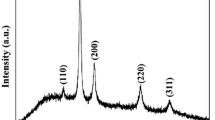Abstract
Cu2O@Au yolk/shell structures were successfully prepared with a facile self-generated acid etching method at room temperature. The morphology is controllable by adding different amount of HAuCl4·4H2O. Scanning electron microscopy and transmission electron microscopy images showed that Au nanoparticles self-assembled into a porous shell around Cu2O core while the produced etching agent etched the core gradually and formed the cavity. The photocatalytic property of Cu2O@Au yolk/shell structures was studied by degrading MO under the irradiation of visible light at room temperature. Benefiting from the synergistic effect of cavity micro-reactor and electron transfer, the photocatalytic performance of the as-prepared Cu2O@Au yolk/shell structures was much better than that of pure Cu2O. The possible photocatalytic mechanism of the Cu2O@Au yolk/shell catalysts was proposed and elaborated in this study. It is certified that Yolk/shell structures have potential applications in photocatalysis for its active sites on the large specific area.










Similar content being viewed by others
References
Boyjoo Y et al (2017) A review on photocatalysis for air treatment: from catalyst development to reactor design. Chem Eng J 310(Part 2):537–559
Li F et al (2017) Enhanced removal of azo dye using modified PAN nanofibrous membrane Fe complexes with adsorption/visible-driven photocatalysis bifunctional roles. Appl Surf Sci 404:206–215
Molinari A et al (2017) Degradation of emerging concern contaminants in water by heterogeneous photocatalysis with Na4W10O32. Appl Catal B 203:9–17
Spasiano D et al (2015) Solar photocatalysis: materials, reactors, some commercial, and pre-industrialized applications. A comprehensive approach. Appl Catal B 170–171:90–123
Friehs E et al (2016) Toxicity, phototoxicity and biocidal activity of nanoparticles employed in photocatalysis. J Photochem Photobiol, C 29:1–28
Cheng G et al (2016) Enhanced adsorption and photocatalysis capability of generally synthesized TiO2-carbon materials hybrids. Adv Powder Technol 27(5):1949–1962
Ahmed G et al (2016) Defect engineering of ZnO nanoparticles by graphene oxide leading to enhanced visible light photocatalysis. J Mol Catal A: Chem 425:310–321
Peng F et al (2017) Construction of (001) facets exposed ZnO nanosheets on magnetically driven cilia film for highly active photocatalysis. Appl Surf Sci 394:115–124
Wang F et al (2016) Fabrication and shape evolution of petal-like Cu2O nanocrystal toward enhanced photoactivity and stability for hydrogen generation under visible light irradiation. J Alloy Compd 688(Part A):632–638
Fagan R et al (2016) A review of solar and visible light active TiO2 photocatalysis for treating bacteria, cyanotoxins and contaminants of emerging concern. Mater Sci Semicond Process 42(Part 1):2–14
Geng Z et al (2015) Incorporation of Cu2O nanocrystals into TiO2 photonic crystal for enhanced UV–visible light driven photocatalysis. J Alloy Compd 644:734–741
Zhang W et al (2016) Au/Cu2O Schottky contact heterostructures with enhanced photocatalytic activity in dye decomposition and photoelectrochemical water splitting under visible light irradiation. J Alloy Compd 684:445–452
Zoolfakar AS et al (2013) Nanostructured copper oxides as ethanol vapour sensors. Sens Actuators B Chem 185:620–627
Tadjarodi A, Akhavan O, Bijanzad K (2015) Photocatalytic activity of CuO nanoparticles incorporated in mesoporous structure prepared from bis(2-aminonicotinato) copper(II) microflakes. Trans Nonferrous Metals Soc China 25(11):3634–3642
Ma J et al (2015) Preparation, characterization and antibacterial activity of core–shell Cu2O@Ag composites. Surf Coat Technol 272:268–272
Dhiman M, Chalke B, Polshettiwar V (2017) Organosilane oxidation with a half million turnover number using fibrous nanosilica supported ultrasmall nanoparticles and pseudo-single atoms of gold. J Mater Chem A 5(5):1935–1940
Cassano D et al (2017) Passion fruit-like nano-architectures: a general synthesis route. Sci Rep 7:43795
Bonyár A et al (2016) Investigation of the performance of thermally generated Au/Ag nanoislands for SERS and LSPR applications. Proc Eng 168:1152–1155
Xuming Z et al (2013) Plasmonic photocatalysis. Rep Prog Phys 76(4):046401
Jiang R et al (2014) Metal/Semiconductor Hybrid Nanostructures for Plasmon-Enhanced Applications. Adv Mater 26(31):5274–5309
Purbia R, Paria S (2015) Yolk/shell nanoparticles: classifications, synthesis, properties, and applications. Nanoscale 7(47):19789–19873
Li Z et al (2016) Design of highly stable and selective core/yolk–shell nanocatalysts—a review. Appl Catal B 188:324–341
Zhang Q et al (2012) Core–shell nanostructured catalysts. Acc Chem Res 46(8):1816–1824
Li G, Tang Z (2014) Noble metal nanoparticle@ metal oxide core/yolk–shell nanostructures as catalysts: recent progress and perspective. Nanoscale 6(8):3995–4011
Pang M et al (2012) Self-Generated Etchant for Synthetic Sculpturing of Cu2O-Au, Cu2O@Au, Au/Cu2O, and 3D-Au Nanostructures. Chemistry 18(46):14605–14609
Liu X (2011) Cu2O microcrystals: a versatile class of self-templates for the synthesis of porous Au nanocages with various morphologies. RSC Adv 1(6):1119–1125
Wang Y et al (2016) Size Control and Growth Process Study of Au@Cu2O Particles. Nanoscale Res Lett 11(1):390
Premkumar T et al (2007) A facile and efficient “one-step” synthesis of Auo with tunable size. Gold Bull 40(4):321–327
Acknowledgements
This work was supported by a key project for Industry-Academia-Research in Jiangsu Province (BY2016043-01), the Enterprise Cooperation Projects (P110900316).
Author information
Authors and Affiliations
Corresponding author
Ethics declarations
Conflicts of interest
The authors declare that they have no conflict of interest.
Electronic supplementary material
Below is the link to the electronic supplementary material.
Rights and permissions
About this article
Cite this article
Chen, R., Lu, J., Liu, S. et al. The preparation of Cu2O@Au yolk/shell structures for efficient photocatalytic activity with a self-generated acid etching method. J Mater Sci 53, 1781–1790 (2018). https://doi.org/10.1007/s10853-017-1614-4
Received:
Accepted:
Published:
Issue Date:
DOI: https://doi.org/10.1007/s10853-017-1614-4




